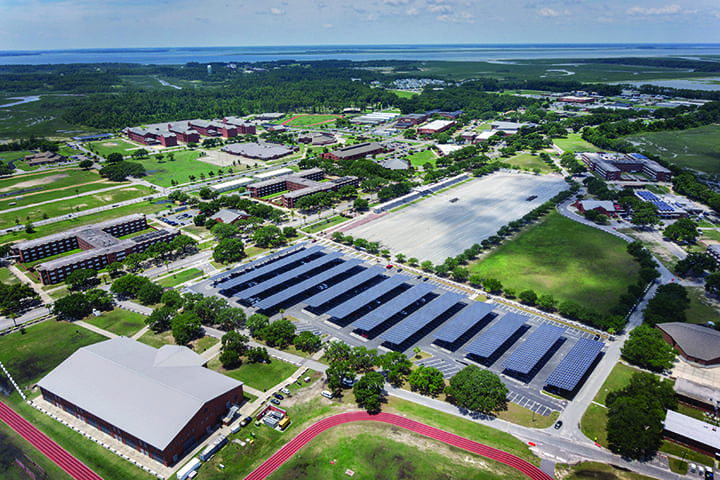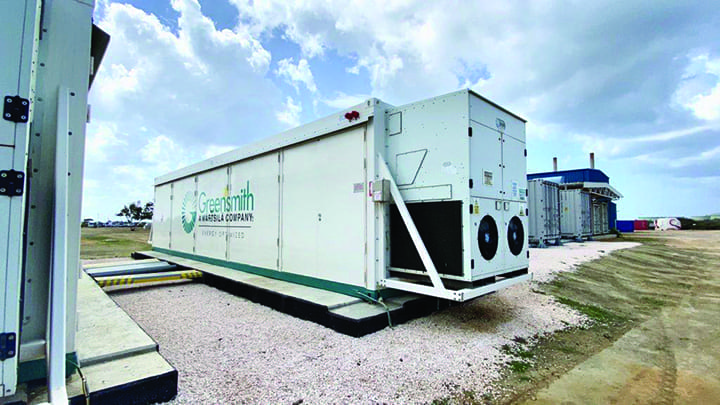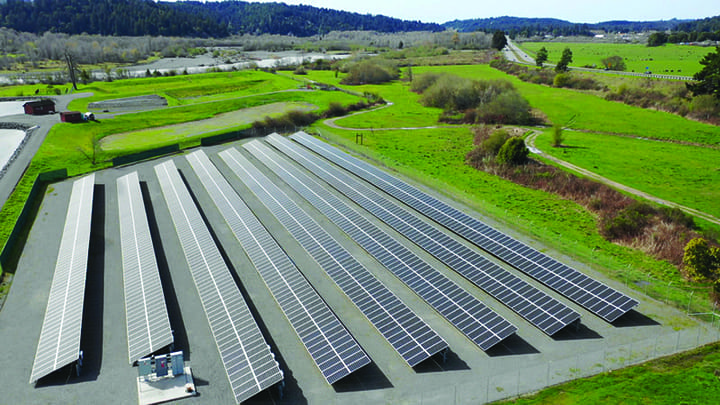Micro Generation with Macro Possibilities
The market for microgrids continues to expand, with utilities, businesses, and neighborhoods installing a variety of technologies in systems designed to ensure a reliable and resilient supply of power.
The benefits of microgrids have been increasingly recognized in recent years, as sources of both backup and at times primary power. The systems provide reliability and energy security, can be at the heart of sustainability programs for businesses, and are decreasing electricity costs for consumers. They also are an important tool to bring electricity to areas unable to access the traditional grid.
Governments are supporting their construction. Market dynamics are being helped by investment tax credits, feed-in tariffs, tax rebates, and more for microgrid technologies, including solar power and battery storage.
 |
|
1. Ameresco built a 10-MW microgrid at the U.S. Marine Corps Recruit Depot at Parris Island, South Carolina. The $91 million project, which came online in mid-2019, includes solar and battery storage and is designed to withstand storms and earthquakes. Courtesy: Ameresco |
Market players in the microgrid space are investing in research and development, devising control systems designed to improve efficiency and provide operational flexibility. Microgrids are increasingly being adapted to work in diverse settings, such as at hospitals and military bases (Figure 1), and in both urban and rural environments, with new technologies integrated to improve their effectiveness and expand their applications.
“Technology is advancing rapidly to enhance the deployment of microgrids,” Don Wingate, vice president for Utility & Microgrid Solutions at Schneider Electric, told POWER. “As the technology has advanced, we are now seeing more repeatable and scalable solutions that can fit different applications.”
New Jersey has been working on a statewide microgrid network after the massive power outages caused by Superstorm Sandy in 2012. The state’s Board of Public Utilities has chosen more than a dozen communities to each host a Town Center Distributed Energy Resources Microgrid, or TCDER. California is looking at microgrids to provide power in areas prone to wildfires, to ensure reliable power when utilities implement public safety power shutoff (PSPS) protocols to help prevent wildfires caused by above-ground electrical equipment.
Maryland in mid-June announced it would help finance 14 new microgrid projects, winners in the state’s resilience solicitation, with installations designed to serve neighborhoods, agricultural facilities, and a marine terminal, among others. The proposals feature several technologies, including fuel cells, solar power, battery and thermal storage, and combined heat and power. The state has set aside more than $1 million to support the projects.
“Microgrids continue to be a growth industry and a technology that applies to many segments,” Wingate said. “In North America, most use cases for [a] microgrid are linked to areas with high electric costs, areas prone to natural disaster, business entities that require high power quality and resilience, and more recently people and organizations that want sustainable energy. The watchwords for us are economic advantage, resilience, and sustainability. Today, microgrids make a lot of sense for end-users with these goals.”
Allan Schurr, chief commercial officer of Enchanted Rock, a provider of backup power systems through its microgrid-as-a-service model, was asked by POWER where microgrids are most likely to be deployed in the future. His response? “Everywhere. Microgrids primarily provide economic savings compared to grid power or reliability/resiliency value when the grid is not available or is non-existent. So those benefits result in proliferation of various microgrid configurations based on retail prices/structures and risk of grid disturbances, as well as remote areas without grid infrastructure. The key change is that net prices for microgrids are dropping, which makes economic benefit far more attainable.”
Expanding Technologies
The technologies available for use in microgrids continue to expand. That includes their control systems, which are becoming more sophisticated as different technologies are incorporated.
“In the last two years, the term microgrid is very much in fashion,” said Brian Curtis, CEO of California-based Concentric Power, in an interview with POWER. “If you go back in time, and look at what we’ve been doing the last 10 years, maybe we articulate it and talk about it differently. The one thing that we have doubled down on is the microgrid controller aspect. We developed a system for cogeneration for DERs [distributed energy resources]… we’ve always been of the mindset to do load-following. The controller architecture we developed applies well to all assets, whether it’s engines or batteries, DERs altogether. We think that’s going to be very important to ensure systems work as intended, and also to open up new business models, to be able to monetize on the grid. We are just diving deeper on what we already were doing.”
CleanSpark, a Utah-based company that designs software for microgrids and DER management systems, in May was awarded additional U.S. patent protection for its proprietary energy microgrid distribution system. The company’s software allows a microgrid to be scaled to a user’s specific needs, and the company has implemented its system across commercial, industrial, military, and agricultural sectors.
“Today’s patent specifically protects our proprietary system and method for distributing energy between microgrids,” said CleanSpark CEO Zachary Bradford in a statement. “It particularly addresses the challenge of determining when it is appropriate for one microgrid to share power with another microgrid. In the patented system and method, a microgrid forecasts its own future power needs, [and] the microgrid then uses this forecast to determine if and when to share power with another microgrid.”
Schurr told POWER: “For improved resiliency for certain customers or load pockets, microgrids may be a better alternative than improving the grid serving those customers or a larger area. Non-wires alternatives are being considered by utilities as a more economic option. Sometimes the need is local capacity, sometimes voltage support, but microgrids can be more economical than traditional grid investments.”
Bradford noted the May patent further protects CleanSpark’s technology and the methods the company’s system uses to make decisions related to power-sharing, based on factors such as energy demand, utility rates, time-of-use, and weather forecasting. Others who spoke with POWER noted how microgrids are being valued for increased resiliency, efficiency for cost-avoidance, revenue generation, and reductions in greenhouse gas emissions because many incorporate solar, wind, and energy storage.
“The latest advances in microgrid control systems enable multiple microgrid assets to synchronize and interact with each other,” Jim Thomson, vice chairman, U.S. Power, Utilities & Renewables leader, and lead client service partner for Deloitte Consulting LLP, told POWER. “For example, one utility is implementing microgrid controller software to enable the clustering of multiple adjacent microgrids. A bidirectional power flow feature allows microgrids with excess capacity to bid energy into those with energy needs. The software includes advanced algorithms to manage and optimize the use of DERs for multiple microgrids.”
Significant Role for Storage
Energy storage is now part of many solar and wind power installations, and it’s increasingly being used in microgrid configurations.
John Vernacchia, segment manager for renewable solutions for Eaton’s electrical business, told POWER that energy storage is essential for microgrids. “It enables microgrids to use solar and other DERs more fully, storing power during the day and offsetting peak demand and reducing energy costs.
“Just about every microgrid project we’ve supported uses energy storage. And the installed base of energy storage is expected to increase 13 times by 2030,” Vernacchia said, citing BloombergNEF’s Energy Storage Outlook 2019. “The kind of storage that is used can vary. For example, microgrids that include critical loads and need fast transition are able to tap our EnergyAware UPS [uninterruptible power system] technology. The technology is used for a variety of applications: demand charge management, time-of-use optimization, demand response, frequency regulation, aggregation services, and/or generator replacement or offsetting.”
“Storage is going to be a really big deal, and it’s already happening,” said Concentric’s Curtis. “Where the technology comes in [is on] the controller side of things, where we have the architecture we’re developing. I don’t think it will be a standards war, but an integration of a lot of technologies. Technology architecture that revolves around storage. I think there are going to be some co-existing architectures. Concentric’s take is to keep an open architecture that works well with other controllers. I think there’s going to be a lot of advancement on the controller side.”
“Battery storage can be critical to a resilient, clean, revenue-generating, and grid-enhancing microgrid system that incorporates renewable energy such as wind and solar,” said Deloitte’s Thomson. “Other scenarios that would require storage or uninterruptible power supply (UPS) include critical facilities or loads that cannot take a temporary outage when the primary grid is lost. Mission-critical applications employing microgrids with battery storage can access backup power instantly. Recent natural disasters in many countries have highlighted the opportunity for battery storage coupled with local renewable energy to provide power during an emergency.”
 |
|
2. The Caribbean island of Bonaire is powered by a Wärtsilä microgrid, which includes a battery storage system to help optimize the power supply. Courtesy: Wärtsilä |
Wärtsilä is operating an energy management and battery storage system microgrid (Figure 2) on the Caribbean island of Bonaire. Wärtsilä, working with its utility customer ContourGlobal, has enabled the utility to manage and operate the island’s entire grid with the Greensmith Energy Management System (GEMS) advanced software platform. Wärtsilä acquired Greensmith in 2017.
ContourGlobal is taking a phased approach to modernizing its thermal-based power generation systems in concert with Wärtsilä, to allow the integration of more renewable generation assets without compromising reliability, and to leave room for new technologies on the grid.
“We play in the megawatt-hour scale when it comes to energy storage on the microgrid, be it a physical island grid, or islanded grid, like one serving a mine or industrial facility in a remote location,” said Risto Paldanius, head of Energy Storage Business Development for Wärtsilä, in an interview with POWER. “Our business is, how do you manage or orchestrate all these assets for the lowest cost of electricity and the lowest environmental impact?
“On the island of Bonaire, we’re really optimizing thermal assets with wind, for the lowest LCOE [levelized cost of energy] and lowest emissions,” Paldanius said. “You need to be able to optimize the assets on the ground already, and be able to bring on new assets, and it’s important to have the flexibility on the software side to do that.”
Microgrid Networks
There’s an urgency around the creation of microgrid networks, in large part due to the hurricanes, wildfires, and other natural disasters that have caused widespread power outages in recent years.
“The primary goal of a microgrid is energy resiliency,” said Deloitte’s Thomson. “As such, the most significant growth opportunities for microgrids are in disaster-prone areas subject to repeated or long-duration outages, such as the most wildfire-prone areas of California or parts of Australia. The value proposition for microgrids may currently be highest in areas of California,” due to the PSPS protocols during high-wind and high-temperature events. “California businesses, households, and communities are seeking ways to keep the lights on during these shutdowns, so demand for backup generators, portable power stations, and microgrids with battery storage has been growing.”
 |
|
3. The microgrid at Blue Lake Rancheria in California includes a 430-kW solar photovoltaic array from REC Solar. Courtesy: Blue Lake Rancheria |
Among the most talked-about microgrids in California’s fire zone is at Blue Lake Rancheria (Figure 3), a century-old Native American reservation in Northern California near Eureka. The microgrid, which came online in 2017, helps power government offices, other businesses, and Red Cross shelters at a 100-acre site. The system, built in collaboration with Humboldt State University’s Schatz Energy Research Center, along with Siemens, Idaho National Laboratory, and other partners, includes two legacy backup diesel generators, with combined output of about 1.8 MW, a 430-kW solar photovoltaic (PV) array from REC Solar, and a 950-kWh Tesla battery storage system. The microgrid is managed and controlled with Spectrum Power Microgrid Management System software from Siemens. The microgrid enables the reservation to operate independently of the local grid, in coordination with Pacific Gas & Electric (PG&E).
The Blue Lake Rancheria Tribe, a federally recognized sovereign nation, was originally established in 1908 as a refuge for homeless Native Americans. In October 2019, it became a refuge and haven for the local community, when PG&E pre-emptively shut off power to several California counties to prevent the utility’s equipment from sparking wildfires. The reservation suddenly was one of the only gas stations with power, and it also was able to provide diesel to United Indian Health Services to refrigerate medications, and to the Mad River Fish Hatchery to keep the facility’s fish alive. Many area residents came to Blue Lake to charge cell phones.
Jana Ganion, the reservation’s sustainability director, told National Public Radio (NPR) earlier this year that Blue Lake “had probably 30- to 45-minute gas lines” during the power shutoff. “People were fueling up vehicles, but also their home generators. That continued, basically, for the duration of the 28-hour outage.” Ganion told NPR she estimates more than 10,000 local residents came to the reservation for gas and supplies during the outage. The Blue Lake project has worked so well that the reservation is adding two more microgrids—one set to begin operating this year, and another in 2022, which will more than double the amount of power produced in this first project.
Eye Toward the Future
The adaptability of microgrids and the “innovations related to their potential application in diverse settings” are among the reasons the technology will continue to grow, according to Ed Patricoff, a partner with Shutts & Bowen in the firm’s Miami, Florida, office. Patricoff has particular experience with energy projects in developing nations, and said the trend toward digitalization in the power generation sector favors microgrid adoption.
Patricoff told POWER: “The World Economic Forum estimates that digitalization will create $1.3 trillion of value globally by 2025 by increasing asset lifespans, optimizing electricity flows, and creating innovative customer-centric products. The digitalization of the electric industry is being propelled, and is helping to facilitate, another trend: the decentralization of energy transactions.”
That decentralization is key for developing nations and rural areas without access to a traditional power grid. “In developing countries microgrids are really the best tool to provide access to energy,” said Schneider’s Wingate. “Building large and expensive centralized grids are no longer feasible or technically advantageous. Microgrids are the most promising solutions for developing countries and the most cost-effective solution to provide access to energy.”
That cost-effectiveness is bringing utilities to the market.
“Utilities are already investing in microgrids,” said Eaton’s Vernacchia. “For example, we recently helped an investor-owned utility in the U.S. deploy a microgrid that incorporates solar and storage, and will be used for testing a variety of applications such as demand response, peak shaving, and resiliency. Eaton is also working on multiple projects with another large utility that range from energy storage at substations for peaking and deferment of upgrades, to microgrids sited at customer locations that benefit the utility under normal conditions and provide customers with backup power during outages. We’re also working with a municipal utility to deploy a microgrid in its distribution system to reduce emissions. Utilities are actively deploying microgrids to meet their business goals.” ■
—Darrell Proctor is associate editor for POWER (@DarrellProctor1, @POWERmagazine).